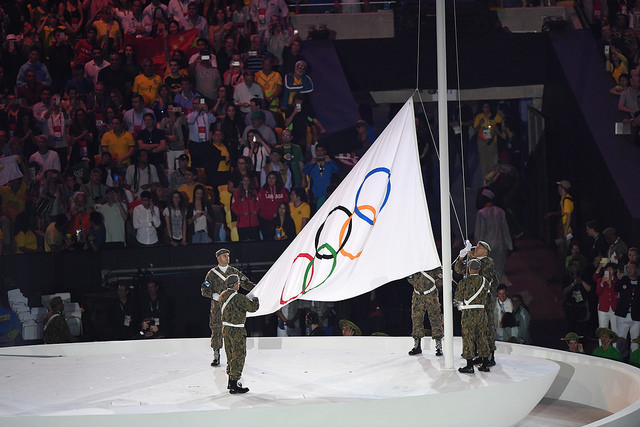
Despite the rhetoric about the Olympics bringing the world together peacefully to celebrate athletic achievement, the competition is oddly divided according to “their genitalia and the patch of land on which they were born” (as colleague Craig Martin put it on Facebook). We see some wonderful examples of international goodwill, certainly (some listed here), but the arbitrary divisions dominate, both through the flag-waving spectators in the stands and the daily medal counts according to nation in the media. Whether it is people in India cheering P.V. Sindhu, who reached the Badminton women’s individual finals last Friday, or people in the United States cheering for Simone Biles’ five medal performance in gymnastics, the division into nationalities takes on the appearance of being a natural description.
The organization of the Olympics, demonstrated from the Opening Ceremony Parade of Nations, and the media coverage that focuses on the nation’s athletes make the nation appear to be a natural division, an obvious identifier (a la Benedict Anderson’s Imagined Communities). We often cheer for people from our own country because their victory brings us status, even though we have little if anything in common with the athletes, potentially being from different regions, living within different social networks, holding different commitments, etc.
The imagination of these communities is so effective that we forget that organizing the Olympics according to nationality is an arbitrary choice. We could organize everyone according to mother tongue, for example, bringing together many from the US, Canada, Great Britain, and Australia, among others, as those identifying English as their mother tongues. Teams such as India and China would be divided into a range of language groups, meaning that those gaining status for Sindhu’s silver medal would be significantly fewer. When two regions of India both claimed Sindhu as their own, her coach responded, “Well, I can only say she belongs to India” further reinforcing the primacy of the national division.
Discussion of the complexity of gender identifications and the question of hyperandrogenous runner Caster Semenya highlights the arbitrary nature of the gender binary, as people who do not conform to that binary generate controversy. We could also divide people according to size (as they do in a few sports). The arbitrary division of players into an Under-6-Foot basketball competition, for example, would highlight a different set of athletic skills.
The ways that we divide up the world become naturalized beyond the organization of the competition. The media emphasis on Simone Manuel, Simone Biles, and Gabby Douglas as role models for African-American females and Ibtihaj Muhammad for Muslim-American females also reflects an arbitrary division like the division by nationality. Simone Biles and Gabby Douglas (like many female gymnasts) could also be seen as a role model for those who are shorter than 5 feet. Of course, that is not a typical community in the ways that Muslim-American and African-American become common divisions of people into communities.
In these ways the differences that serve to organize the world, including the mythically unifying Olympics, are fabricated, selected and emphasized among the various traits that we could emphasize. The Olympics do not fabricate these arbitrary differences out of nothing, but in reflecting these common fabricated differences, the Olympics reinforce them, further naturalizing those particular differences as automatic ways of organizing the world, while a person’s height or mother tongue are much less common, and thus seemingly odd, ways of dividing people.
Photo “Rio 2016 Olympic Games Opening Ceremony, Aug. 5, 2016” by Tim Hipps, US Army Family and MWR Programs via Flickr (CC BY 2.0).
